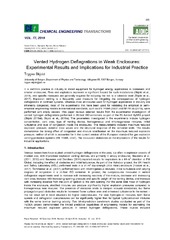Vented hydrogen deflagrations in weak enclosures: Experimental results and implications for industrial practice
Peer reviewed, Journal article
Published version

Åpne
Permanent lenke
https://hdl.handle.net/1956/21808Utgivelsesdato
2019Metadata
Vis full innførselSamlinger
Originalversjon
https://doi.org/10.3303/cet1977115Sammendrag
It is common practice in industry to install equipment for hydrogen energy applications in containers and smaller enclosures. Fires and explosions represent a significant hazard for such installations (Skjold et al., 2018), and specific measures are generally required for reducing the risk to a tolerable level (Skjold et al., 2017). Explosion venting is a frequently used measure for mitigating the consequences of hydrogen deflagrations in confined systems. Whereas most enclosures used for hydrogen applications in industry are inherently congested, most of the experiments that have been used for validating the empirical or semi-empirical engineering models in international standards, such as EN 14994 (2007) and NFPA 68 (2018), were performed with empty vessels. This paper reviews selected results from the experimental investigation of vented hydrogen deflagrations performed in 20-foot ISO containers as part of the EU-funded HySEA project (Skjold 2018ab; Skjold et al., 2019a). The parameters investigated in the experiments include hydrogen concentration, vent area, type of venting device, homogeneous and inhomogeneous mixtures, initial turbulence and level of congestion inside the enclosures. The measurements included maximum reduced explosion pressure, external blast waves and the structural response of the container walls. The results demonstrate the strong effect of congestion and mixture stratification on the maximum reduced explosion pressure, neither of which is accounted for in the current version of the European standard for gas explosion venting protective systems (EN 14994, 2007). The discussion elaborates on the implications of the results for industrial applications.